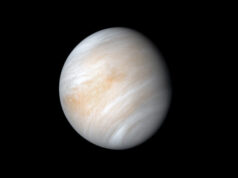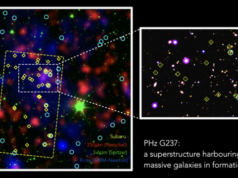Above animation shows how the scientists discovered 2015 FJ345 from the images with Hyper Suprime-Cam at the Subaru Telescope. The observation took place on March 17, 2015, and the interval between the individual images is 2 hours. (Credit: Scott S. Sheppard/David Tholen/Chad Trujillo)
The search for distant solar system objects has found two more small worlds far outside the orbit of Neptune. The new objects are located beyond the Kuiper Belt, which is a belt of small icy objects just beyond Neptune, of which Pluto is a member. They have the third and fourth most-distant perihelia, which is when an object has its closest approach distance to the Sun, of any known solar system objects.
In addition, the orbital motions of these objects are in resonance with Neptune’s orbit, which was somewhat unexpected. Their orbital paths imply that these worlds either have interacted with Neptune in the past or are continuing to do so – despite their great distances from the ice giant planet.
This latest discovery is based on observations made with the Subaru Telescope in Hawai’i and Cerro Tololo Inter-American Observatory (CTIO) telescope in Chile, and is described in a paper published in the July 2016 edition of Astrophysical Journal Letters.
Dr. Scott S. Sheppard (Carnegie Institution for Science) and his collaborators Dr. Chadwick Trujillo (Gemini Observatory at the time of the research) and Dr. David J. Tholen (University of Hawai’i) have been conducting the widest, deepest survey ever to search out distant solar system objects. The team members started their survey using the Suprime-Cam imager at the Subaru Telescope several years ago. Their main goal is to find extreme Trans-Neptunian objects and they already have successfully found several. Now with the new Hyper Suprime-Cam on Subaru, they are able to cover a lot more of the sky than in the past in their searches for faint distant worlds.
Find your dream job in the space industry. Check our Space Job Board »
The Story Behind the Discovery
In 2014, the team predicted the existence of a Super-Earth-mass planet orbiting beyond a few hundred astronomical units (AU) away from the Sun. Its gravitational influence appears to be pushing the extreme Trans-Neptunian objects into similar types of orbits. The team is continuing a survey looking for this massive distant planet, but need to find more of the smaller objects, which can then lead them to the bigger object.
In their paper, the team members describe the discovery of the two new objects, and how these two new objects have very distant perihelia but don’t have extreme semi-major axes or eccentricities like the other high-perihelion extreme trans-Neptunian objects (TNOs) such as Sedna and 2012 VP113. In fact, these newly found worlds occupy a region of space just beyond what is known as the “Kuiper Belt edge,” which lies about 50 AU from the Sun. Until this most recent discovery, only one object was known to have a low-to-moderate semi-major axis and a perihelion beyond this edge. The team discovered several more of these objects with high perihelion but moderately eccentric orbits. Their semi-major axes are in the range of about 60 to 100 AUs.
What was surprising is that these new objects are all near Neptune Mean Motion Resonances (that is, the locations of their orbits have specific period ratios with respect to that of Neptune). One of the new objects goes around the Sun once every time Neptune goes around 4 times, while the other new objects go around once every time Neptune goes around 3 times. The new objects also have significant inclinations in their orbits and thus are effected by the Kozai resonance, which was first shown to effect high inclination objects by Yoshihide Kozai in 1962. This finding suggests these worlds were captured into this rare orbital region through interactions with Neptune while that planet was migrating outwards in the solar system in the distant past. Neptune was born much closer to the Sun than its current position, and its migration outwards disturbed other, smaller objects into these distant orbits we see today. Thus, these objects give us insights into the movement of Neptune during the very early history of the solar system.
The discovery and characterization of these objects and their orbits are described in the “Beyond the Kuiper Belt edge: New high perihelion Trans-Neptunian Objects with moderate semimajor axes and eccentricities” by Scott S. Sheppard, Chadwick Trujillo, and David J. Tholen, published July 1, 2016 inAstrophysical Journal Letters (Volume 825).
Source: Subaru Telescope
Journal reference: Astrophysical Journal Letters











